Creature Feature

Gather at the Watering Hole
By Wayne Bierbaum
When walking at Terrapin Nature Park in Stevensville, the day after a rain, I found a muddy puddle lined with bright purple butterflies. They were very intent in continuing to drink the muddy water and one allowed me to lift it on my mud-covered finger. Because the mud was pretty ugly looking I could not get a good photo of the group but one did land in the sun on a phragmites stalk.
The butterfly that is most often found lined around a mud puddle is the red-spotted purple (Limenitis arthemi). The red-spotted purple is classified as a brush-footed butterfly—a large group of butterflies that have reduced sized front legs with fuzzy tips.
Unusually, the red-spotted purple is also considered to be the same butterfly as the white admiral. The white admiral butterfly has a large white stripe on its wing and is the northern form of Limenitis arthemi; in areas where they overlap with red-spotted purples, there are fusion forms.
Just like the viceroy butterfly looks like a monarch, red-spotted purple and white admirals are mimics of a poisonous species, the pipevine swallowtail butterfly. This offers them some protection from animals that have tasted the pipevine swallowtail.
The red-spotted purple caterpillar is also a mimic. Only it mimics bird poop. The caterpillars feed on willow, poplar, and cherry leaves. In our area, there are usually two generations a year. The second set of caterpillars mature into a pupa and hide underground until spring. They then will emerge as a butterfly.
Plant a butterfly garden with native plants or go visit a butterfly garden in the fall to see the most butterflies. And as always, avoid the use of pesticides.
